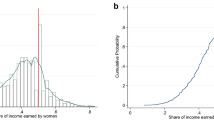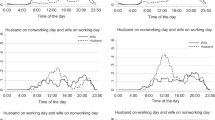Abstract
Researchers have proposed that work-family policy use may either reinforce or challenge the existing gendered division of labor within couples, but results from prior studies have been inconclusive. Using data from a regional survey of work and family life, we extend this research by focusing on how housework is divided within couples and by differentiating between traditionally female- and male- typed housework tasks. Results show that among dual-earning women, policy use is not related to share of female- or male-typed tasks. Among dual-earning men, policy use is positively related to share of female-typed tasks and negatively related to share of male-typed tasks. These findings suggest that work-family policy use does not reinforce the gendered division of housework.
Similar content being viewed by others
Notes
To assess data representativeness, we compared our sample statistics for dual-earning men and women to nationally representative data on dual-earning men and women from the 1997 National Survey of the Changing Workforce (NSCW). Although the NSCW is a sample of workers, while ours is a sample of families with dependent children, the surveys are alike on a number of demographic and economic indicators. In fact, on most important work and family-related indicators, the samples are virtually identical. For instance, women in our sample are only slightly better educated than those in the NSCW, and there is no education difference among men. A little more than one-third of men and women in both samples worked in professional and managerial jobs. Of four work-family policies that were comparably measured across the samples (i.e., flexible scheduling, parental leave, sick leave, and child care availability), the average number of available policies was approximately two for both samples. The average workweek of men was 47 h in our sample and 48 h in the NSCW, although the difference for women was a little larger at 35 in our sample compared to 41 in the NSCW. Finally, the mean incomes of men and women is similar in both samples, with men in our sample earning an average of approximately $46,000 compared to $48,000 in the NSCW; women in our sample earned approximately $29,000, compared to $25,000 in the NSCW.
The z-test uses the following formula: \( {\text{z}} = {\text{b}}_{M} - {\text{b}}_{W} /{\sqrt {{\text{SE}}^{{\text{2}}}_{{{\text{bm}}}} + {\text{SE}}^{{\text{2}}}_{{{\text{bw}}}} } } \)
References
Auerbach, J. (1990). Employer supported child care as a woman-responsive policy. Journal of Family Issues, 11, 384–400.
Becker, G. S. (1991). A treatise on the family. Cambridge, MA: Harvard University Press.
Bergman, B. (1998). Watch out for ‘family friendly’ policies. Dollars and Sense, 215, 10–11.
Bianchi, S. M., Milkie, M. M., Sayer, L. C., & Robinson, J.P. (2000). Is anyone doing the housework? Social Forces, 79, 191–228.
Blair, S. L., & Lichter, D. T. (1991). Measuring the division of household labor: Gender segregation of housework among American couples. Journal of Family Issues, 12, 91–113.
Blood, R. O., & Wolfe, D. M. (1960). Husbands and wives: The dynamics of married living. New York: Free Press.
Boden, R. J., Jr. (1999). Flexible work hours, family responsibilities, and female self-employment: Gender differences in self-employment selection. American Journal of Economics and Sociology, 58, 71–83.
Bohen, H. H., & Viveros-Long, A. (1981). Balancing jobs and family life: Do flexible work schedules help? Philadelphia: Temple University Press.
Ciabattari, T. (2001). Changes in men’s conservative gender ideologies: Cohort and period influences. Gender and Society, 15, 574–591.
Ciscel, D., Sharp, D. C., & Heath, J. A. 2000. Family work trends and practices: 1971–1991. Journal of Family and Economic Issues 21, 23–36.
Cohen, J., & Cohen, P. (1983). Applied multiple regression/correlation analysis for the behavioral sciences (2nd ed.). Hillsdale, NJ: Lawre3nce Erlbaum.
Coltrane, S. (2000). Research on household labor: Modeling and measuring the social embeddedness of routine family work. Journal of Marriage and Family, 62, 1208–1233.
Drago, R., Costanza, D., Caplan, R., Brubaker, T., Cloud, D., Harris, N., Kashian R., & Riggs, T. L. (2001). The willingness to pay for work-family policies: A study of teachers. Industrial and Labor Relations Review, 55, 22–41.
Drago, R., & Hyatt, D. (2003). Symposium: The effect of work-family policies on employees and employers. Industrial Relations, 42(2), 139–144.
Estes, S. B. (2005). Work-family arrangements and parenting: Are “family-friendly” aspects of workplaces related to family life? Sociological Perspectives, 48, 293–317.
Glass, J. L., & Estes, S. B. (1997). The family responsive workplace. Annual Review of Sociology, 23, 289–313.
Glass, J., & Finley, A. (2002). Coverage and effectiveness of family responsive workplace policies. Human Resource Management Review, 12, 313–337.
Hochschild, A., & Machung, A. (1989). The second shift: Working parents and the revolution at home. New York: Viking Press.
Hundley, G. (2001). Domestic division of labor and self/organizationally employed differences in job attitudes and earnings. Journal of Family and Economic Issues, 22, 121–139.
LaRossa, R., & LaRossa, M. M. (1981). Transition to parenthood. Beverly Hills, CA: Sage.
Letters to the Editor. (1989, March-April). Harvard Business Review, May-June, 182–183, 186, 190,192, 194, 197–198, 200–201, 204, 206, 208.
Levine, J. A., & Pittinsky, T. L. (1997). Working fathers: New strategies for balancing work and family. New York, NY: Harcourt Brace.
Marini, M. M., & Shelton, B. A. (1993). Measuring household work: Recent experience in the United States. Social Science Research, 22, 361–382.
Noonan, M. (2001). The impact of domestic work on men and women’s wages. Journal of Marriage and Family, 63, 1134–1135.
Noonan, M., Estes, S. B., & Glass, J. (2007). Does the use of work-family policies influence time spent in domestic labor? Journal of Family Issues, 28, 263–288.
Presser, H. B. (1994). Employment schedules among dual-earner spouses and the division of household labor by gender. American Sociological Review, 59, 348–364.
Ross, C. (1987). The division of labor at home. Social Forces, 65, 816–833.
Sanchez, L., & Kane, E. W. (1996). Women’s and men’s constructions of perceptions of housework fairness. Journal of Family Issues, 17, 358–387.
Sayer, L. C. (2005). Gender, time, and inequality: Trends in women’s and men’s paid work, unpaid work, and free time. Social Forces, 84(1), 285–303.
Schwartz F. N. (1989). Management women and the new facts of life. Harvard Business Review, 89(1), 68.
Silver, H. (1993). Homework and domestic work. Sociological Forum, 18, 181–204.
Silver, H., & Goldscheider, F. (1994). Flexible work and housework: Work and family constraints on women’s domestic labor. Social Forces, 72, 1103–1119.
Sullivan, C., & Lewis, S. (2001). Home-based telework, gender, and the synchronization of work and family. Gender, Work and Organization, 8, 123–145.
Voydanoff, P. (2005). Consequences of boundary-spanning demands and resources for work-to-family conflict and perceived stress. Journal of Occupational Health Psychology, 10, 491–503.
Walzer, S. (1998). Thinking about the baby: Gender and transitions into parenthood. Philadelphia: Temple University Press.
Author information
Authors and Affiliations
Corresponding author
Rights and permissions
About this article
Cite this article
Estes, S.B., Noonan, M.C. & Maume, D.J. Is Work-Family Policy Use Related to the Gendered Division of Housework?. J Fam Econ Iss 28, 527–545 (2007). https://doi.org/10.1007/s10834-007-9075-6
Published:
Issue Date:
DOI: https://doi.org/10.1007/s10834-007-9075-6




